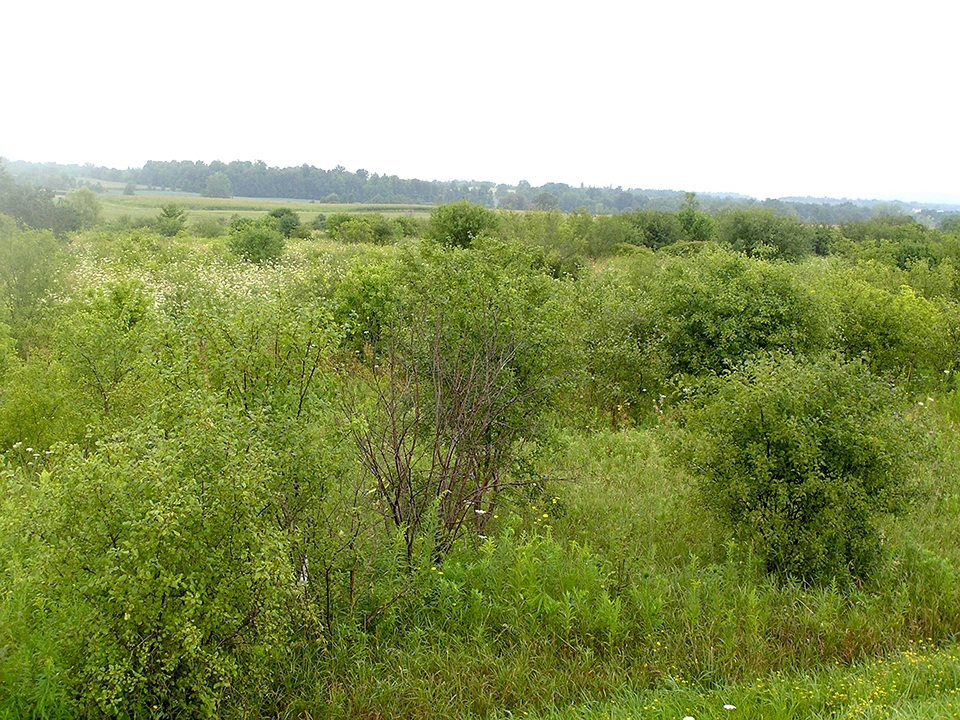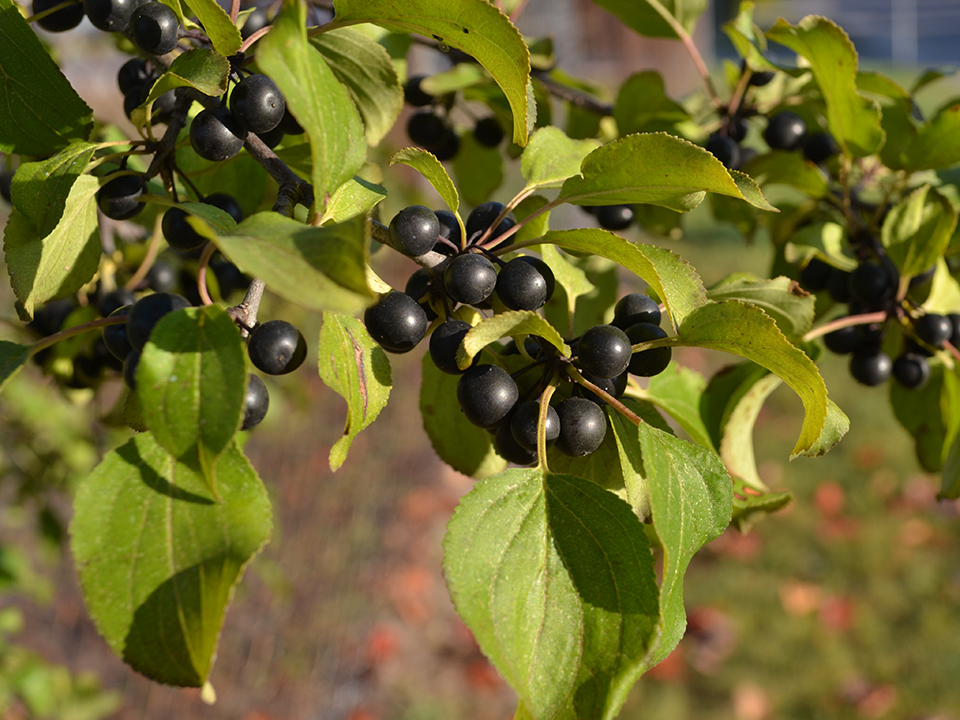
In old fields buckthorn grows as a multi-stemmed large bush or small tree. It quickly comes to dominate this habitat outcompeting all other vegetation.
Species Name: Rhamnus cathartica
Common Name: Common buckthorn
Origin: Eurasia
Distribution: Found throughout the eastern US
Identification: Common buckthorn is a large shrub to small tree that grows to about 20 ft tall and can reach up to 10” in diameter on old trees but more generally stems range between 2 to to 6” in dimater. The bark is dark brown to nearly black. Bark resembles trees in the prunus (cherry) family but prunus species do not have spines that are almost always present on buckthorn. Leaves and twigs are opposite from each other along the branch. Twigs and branches make an almost 70 to 80 degree angle with the main stem. Twigs usually end in a sharp spine, which is diagnostic for common buckthorn. When cut the cambium is creamy-yellow and heartwood is a dull yellowish-orange. Plants tend to be dioecious producing either male or female flowers on separate plants. Female plants produce copious quantities of small black fruits on a short stalk. Fruits are produced in clusters along the branches and persist into winter.
Leaves are oval, dark glossy green approximately 2 to 3 “ long with a 1” long petiole. Leaves have prominent vienation and leaf margins are serrated. Leaf tips are usually pointed but sometimes rounded. Leaves do not change color in the fall and persist until cold or snow makes them fall. Fall is one of the best times to identify buckthorn as the leaves of nearly all native plants turn color while buckthorn leaves remain dark green providing easy identification.
Diagnostic characteristics:
Look for sharp straight spines on the ends of small twigs.
Bark is nearly black in color. Only cherry trees have similar dark bark and could be misidentified for buckthorn, but cherry do not have spines on their twigs.
Leaf color is dark green and leaves do not change color in the fall.
Leaves remain green well into fall and remain on the plant until they are knocked off by heavy frost or snow. The green foliage stands out against the backdrop of the fall color of native plants. Dark black fruits in clusters along the branches. No other native plants have fruit like this.
Biology and Spread: Buckthorn has the ability to germinate and grow in a variety of soil and light conditions making it a threat to nearly all habitats. It readily invades old fields, hedgerows, forest edge and interior forests. Buckthorn is often one of the first woody plants to become established in old fields and waste places and this can lead to its spread and eventual domination. Birds readily spread its seeds from nearby sources. Once a few plants become established and begin to produce seeds it is inevitable that buckthorn will continue to spread throughout the surrounding area. Each successive generation of seed producing plants only adds to its spread, filling in the spaces between established buckthorn with more plants eventually creating a dense monoculture where few other plants can grow.
Buckthorn produces prodigious quantities of fruit, which leads to its widespread dissemination and establishment. Plants begin to produce fruit at a very young age, even plants just a few years old can bear fruit. Plants growing in full sun fruit earlier than those growing in shade. The berries remain on the plant throughout the fall and winter and even into spring. Often buckthorn is the only plant still holding berries during the winter months, which increases the likelihood of it being eaten and dispersed by birds. Its consumption by birds should not be interpreted to mean that it is beneficial to birds. Its fruit has low nutritional value compared to native fruits and its harmful impacts on habitat offset any short term food value the fruit may provide.
Ecological threats: Buckthorn is very shade tolerant and readily colonizes the understory of woodlands. Young early successional woodlands with open canopies allowing abundant light to reach the forest floor are especially vulnerable.
Besides being shade tolerant buckthorn also creates a dense shade that few native plants can tolerate. In woodlands, an understory of buckthorn can effectively intercept all of the available sunlight from reaching the ground.
As deer do not browse on buckthorn to any significant degree, high populations of deer have the effect of favoring the establishment of buckthorn. Deer prefer to browse on native tree seedlings and shrubs restricting their growth but ignore buckthorn allowing it to out compete native plants. The combined impact of dense shade and deer herbivory has the affect of creating a biological dessert where few native plants can germinate and grow.
Large buckthorn growing in old fields, develop into broad multi-stemmed trees. Their branches reach outward low to the ground. The canopy shades the ground, creating a ring of bare soil to the very edge of the plant.
Buckthorn also has a deleterious effect on soil health, nutrient recycling, erosion and soil invertebrates. Buckthorn destroys the forest soil community in two ways. Unlike the leaves of native forest trees and shrubs that decompose slowly forming a layer of leaf litter, the leaves of buckthorn are small and decompose very quickly. Most of the buckthorn leaves have disappeared by spring leaving the soil exposed to erosion. The nutrients contained in the leaves are quickly lost by leaching through the soil and there is no leaf litter to provide habitat for fungi, insects, and soil invertebrates.
Buckthorn also reduces forest litter through direct competition for light and nutrients with native plants. Because fewer native plants can grow in the shade of buckthorn there are fewer leaves to add to the leaf litter. In a healthy native forest the ground is covered with a rich layer of decomposing forest litter; this layer of decaying leaves and wood is vital to the health of the forest. As leaf litter decomposes the nutrients it contains is recycled and taken up by plants. Leaf litter also helps to protect the soil from erosion, it protects the soil surface from the direct impact of falling rain, it absorbs and holds moisture helping with water infiltration. Leaf litter also provides habitat for countless forest organisms such as fungi, invertebrates and amphibians that help to support an even greater and more diverse food web and it creates an ideal environment for seedling germination.
Control methods:
1) Cut Stump Treatment:
Cut stump treatment is one of the most efficient methods for controlling buckthorn. The stem is cut close to the ground and the cut surface is treated with glyphosate (Round-up).
A forest clearing saw is the most efficient tool for cutting small diameter woody stems up to 5” in diameter. Using a FCS most stems take only a second or two to cut and treat. A lightweight chain saw is second to the FCS for cutting medium to large diameter buckthorn stems. Even larger stems up to 8” in diameter can be cut with a FCS. The size of stem is only limited by the diameter of the blade and the power of the saw. Efficiency of the FCS declines as the blade gets dull. Sharpen the blade periodically to maintain peak cutting efficiency.
A chain saw will do the job but will take 2 to 4 times longer to treat the same number of stems as can be cut with a FCS.
As buckthorn readily resprouts from the stump after cutting, the cut surface needs to be treated with a herbicide. A 10% to 15% solution of glyphosate (the active ingredient in Round-up) is applied to the cut surface. A hand held spray bottle works well for applying the herbicide to the cut stem. Add a spray colorant to the bottle so you can tell which stems have been treated.
Dense stands of buckthorn seedlings or small plants can be controlled using glyphosate as a foliar spray. Spray from mid summer through fall as long as the leaves are green and actively photosynthesizing.
2) Basal Bark Spray:
A basal bark spray is another efficient method for controlling medium to large buckthorn plants. Basal treatments are extremely fast and effective for treating large multiple stemmed plants. Each plant takes less than a minute or so to treat. The limitation to using basal bark treatments compared to a cut stem treatment is that more herbicide solution will be used. The plants sometimes take a long time to show symptoms and die. The plants are killed standing and the dead stems take longer to decay and break down than if the stems are cut and laid on the ground.
Mix a 20% solution of triclopyr with Bark Oil Blue. Apply the mixture using a spray pump bottle or backpack sprayer. Spray the full circumference of the stem from the soil line up to about 12” to 18” from the ground. Wet the bark thoroughly but not to the point of runoff.
Basal treatments can be used from late spring, through summer, fall and winter, until late winter. Plants can be treated when actively growing in full leaf or when dormant with equal results. Plants treated when dormant will generally not leaf out in the spring. Plants treated when actively growing will gradually show signs of leaf wilting and then continue to die.
3) Manual control:
Small seedlings and saplings may be pulled out by their roots but most plants are too large to easily remove by pulling. A weed wrench or similar device can be used to pull small to medium sized plants when a herbicide application isn’t an option. Manual control takes significant physical effort, is time consuming and imposes significant limits on what size stems can be pulled and how many stems can be treated in a certain time period.
One suggestion that will make using a weed wrench more efficient; cut the stem 2 to 3 ft above the ground and clear away the top, then use the weed wrench to pull the root out of the ground. This method just makes it easier to pull the root without a lot of branches and debris in the way.

In old fields buckthorn grows as a multi-stemmed large bush or small tree. It quickly comes to dominate this habitat outcompeting all other vegetation.

The small black fruit of common buckthorn. No other native fruit looks similar. The fruit is produced in prodigious quantities even setting fruit on very young plants.
It is a low quality food for wildlife as it is low in nutritional value and energy content but because it is often the only plant growing the seeds are widely dispersed by birds.